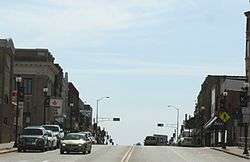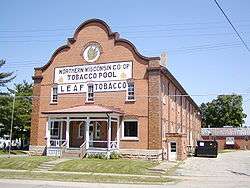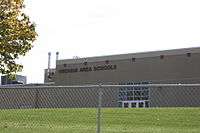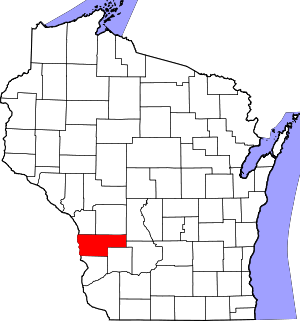Viroqua, Wisconsin
Viroqua is the county seat of Vernon County, Wisconsin, United States. The population was 4,362 at the 2010 census. The city is in the town of Viroqua.
Viroqua | |
|---|---|
| Viroqua, Wisconsin | |
 Viroqua Downtown Historic District | |
 Location of Viroqua in Vernon County, Wisconsin. | |
| Coordinates: 43°33′24″N 90°53′16″W | |
| Country | |
| State | |
| County | Vernon |
| Area | |
| • Total | 4.36 sq mi (11.29 km2) |
| • Land | 4.36 sq mi (11.29 km2) |
| • Water | 0.00 sq mi (0.00 km2) |
| Population | |
| • Total | 4,362 |
| • Estimate (2019)[3] | 4,402 |
| • Density | 1,010.33/sq mi (390.06/km2) |
| Time zone | UTC-6 (Central (CST)) |
| • Summer (DST) | UTC-5 (CDT) |
| ZIP codes | 54665 |
| Area code(s) | 608 |
| FIPS code | 55-82925 |
| Website | www.viroqua-wisconsin.com |
History
The Native American Ho-Chunk inhabited the area now known as Vernon County and the area of Viroqua. The Ho-Chunk, formerly known as the Winnebago, are a Siouan-speaking people who lived in the western Great Lakes region for thousands of years. The Ho-Chunk were removed westward beginning in the 1820s.[4]
There was a sharp rivalry between Viroqua and Springville to be named the county seat of Vernon County. A deed for 40 acres (160,000 m2) of land was promised by pioneer Moses Decker, on condition that Viroqua be chosen as the county seat. The land constituted what became known as the County Addition to the city of Viroqua.[5]
Decker was one of the early settlers in the area. He arrived in 1847 and laid out the village of Viroqua. He died in 1860.[6] Earlier settlers arrived in 1844 and built lumber mills on the Kickapoo River. Farmers began arriving in 1846, some of whom were John Graham, T.J. Defreese and William C. McMichael.[7]
The town was originally named “Farwell” after Leonard J. Farwell, second Governor of Wisconsin, but was renamed “Viroqua” in 1854.[8] It is unclear why the name was changed, and the origins of the name are unclear.[8] One story states that Viroqua was the name of the daughter of Black Hawk.[8] She may have been a character from a novel or the name of a Mohawk Indian actress who performed in a theater on the East Coast or in Brantford, Canada.[8]
In early 1851, the act authorizing the organization of Bad Axe, now Vernon County, was approved by Governor Nelson Dewey. Viroqua was awarded the county seat, pending a permanent location to be determined by a vote. In May 1852, residents voted in favor of Viroqua.[9]
On June 28, 1865, Viroqua was hit by a deadly tornado that left 22 dead.
Geography
Viroqua is located at 43°33′23″N 90°53′15″W (43.556534, -90.887663).[10] According to the United States Census Bureau, the city has a total area of 3.80 square miles (9.84 km2), all land.[11] The city is in the Driftless Region, near the western end of the Ocooch Mountains.

Demographics
| Historical population | |||
|---|---|---|---|
| Census | Pop. | %± | |
| 1880 | 762 | — | |
| 1890 | 1,270 | 66.7% | |
| 1900 | 1,950 | 53.5% | |
| 1910 | 2,059 | 5.6% | |
| 1920 | 2,574 | 25.0% | |
| 1930 | 2,792 | 8.5% | |
| 1940 | 3,549 | 27.1% | |
| 1950 | 3,795 | 6.9% | |
| 1960 | 3,926 | 3.5% | |
| 1970 | 3,739 | −4.8% | |
| 1980 | 3,716 | −0.6% | |
| 1990 | 3,922 | 5.5% | |
| 2000 | 4,335 | 10.5% | |
| 2010 | 4,362 | 0.6% | |
| Est. 2019 | 4,402 | [3] | 0.9% |
| U.S. Decennial Census[13] 2014 Estimate[14] | |||
2010 census
As of the census[2] of 2010, there were 4,362 people, 2,029 households, and 1,059 families residing in the city. The population density was 1,147.9 inhabitants per square mile (443.2/km2). There were 2,208 housing units at an average density of 581.1 per square mile (224.4/km2). The racial makeup of the city was 97.1% White, 0.6% African American, 0.3% Native American, 0.6% Asian, 0.1% Pacific Islander, 0.4% from other races, and 1.0% from two or more races. Hispanic or Latino of any race were 1.0% of the population.
There were 2,029 households, of which 25.5% had children under the age of 18 living with them, 39.0% were married couples living together, 10.0% had a female householder with no husband present, 3.2% had a male householder with no wife present, and 47.8% were non-families. 43.1% of all households were made up of individuals, and 23% had someone living alone who was 65 years of age or older. The average household size was 2.06 and the average family size was 2.86.
The median age in the city was 45 years. 21.6% of residents were under the age of 18; 6.2% were between the ages of 18 and 24; 22.4% were from 25 to 44; 26.3% were from 45 to 64; and 23.6% were 65 years of age or older. The gender makeup of the city was 46.1% male and 53.9% female.
2000 census
As of the census[15] of 2000, there were 4,335 people, 1,990 households, and 1,112 families residing in the city. The population density was 1,327.3 people per square mile (511.9/km2). There were 2,105 housing units at an average density of 644.5 per square mile (248.5/km2). The racial makeup of the city was 98.73% White, 0.07% Black or African American, 0.16% Native American, 0.46% Asian, 0.18% from other races, and 0.39% from two or more races. 0.69% of the population were Hispanic or Latino of any race.
There were 1,990 households, out of which 24.5% had children under the age of 18 living with them, 43.6% were married couples living together, 9.3% had a female householder with no husband present, and 44.1% were non-families. 39.5% of all households were made up of individuals, and 22.7% had someone living alone who was 65 years of age or older. The average household size was 2.10 and the average family size was 2.81.
In the city, the population was spread out, with 21.4% under the age of 18, 7.5% from 18 to 24, 23.3% from 25 to 44, 21.6% from 45 to 64, and 26.2% who were 65 years of age or older. The median age was 44 years. For every 100 females, there were 82.7 males. For every 100 females age 18 and over, there were 77.8 males.
The median income for a household in the city was $28,804, and the median income for a family was $35,475. Males had a median income of $29,589 versus $20,046 for females. The per capita income for the city was $17,172. About 9.8% of families and 12.9% of the population were below the poverty line, including 16.8% of those under age 18 and 12.1% of those age 65 or over.
Transportation
Viroqua is at the intersection of U.S. Highway 14, U.S. Highway 61, Wisconsin Highway 27, Wisconsin Highway 56, and Wisconsin Highway 82.
Recently, the highways and major streets in Viroqua were redone. Highways 14, 61, and 27 had lanes added to them to become four lanes, except for the four block section of downtown. That was kept two lanes to allow for parallel parking on the side of the road.
Viroqua was on the new airways route between La Crosse, Wisconsin, and Rockford, Illinois, when it was established in June 1932. The beacon light had about 15 large 36-inch (910 mm) revolving beacons of 2,000,000 candle power when it was installed on the Mahlon Lepley farm, four miles (6 km) northeast of Viroqua.
Viroqua is served by the Burlington Northern Santa Fe Northern Transcon route between Chicago and the Pacific Northwest.
Airport
Viroqua is serviced by the Viroqua Municipal Airport (Y51).
Economy
Viroqua is an accredited Main Street America city.[16] Its downtown is listed on the Wisconsin and National Register of Historic Places.
Viroqua was dubbed "The Town That Beat Walmart" by Smithsonian Magazine in 1992 because it fostered businesses that co-exist with the retail giant.[17] The city and its nonprofit chamber of commerce, the Viroqua Chamber Main Street, actively promote small business development through several state and federal programs.[18] One noteworthy program that has kept downtown storefronts occupied has been the Pop-Up Shop Initiative, which allow entrepreneurs to use a space downtown rent-free for the holiday season.[19]
Education
- Viroqua High School
- Viroqua Middle School
- Viroqua Elementary School
- Driftless Folk School
- Pleasant Ridge Waldorf School
- English Lutheran School
- Youth Initiative High School
- Laurel High School
- Better Futures High School
- Thoreau College
- Western Technical College offers classes in Viroqua
Culture
The Temple Theatre serves as an arts and cultural center for surrounding counties. A $1.6 million restoration of the 1922 classical revival style vaudeville and movie theater was driven by volunteers.
There are a large number of organic farms in the Driftless Region surrounding Viroqua, which supports startup business ventures, restaurants, and a budding tourism industry.[20]
Notable people
- Joseph D. Beck, U.S. Representative
- J. Henry Bennett, legislator and lawyer
- Cyrus M. Butt, legislator and lawyer
- Henry Conner, legislator
- Andrew H. Dahl, Wisconsin State Legislature
- John Field, football player and coach, businessman
- Frederick C. Finkle, geologist
- Amos Fries, United States Army general
- James Gillett, former Governor of California
- Lawrence Grimsrud, legislator and lawyer
- Frank Bateman Keefe, U.S. Representative
- Mark C. Lee, United States astronaut
- Bernard Lewison, businessman and legislator
- Craig Minowa, musician and environmental activist
- Chris Mulkey, actor and musician, born in Viroqua[21]
- Oliver Munson, Wisconsin State Legislature
- William Nelson, Wisconsin State Senator[22]
- Daniel B. Priest, lawyer and legislator
- Brian Rude, Wisconsin State Legislature
- Jeremiah McLain Rusk, governor of Wisconsin, Secretary of Agriculture
- Lycurgus J. Rusk, Wisconsin legislator, soldier and lawyer
- Rudy Silbaugh, Wisconsin State Legislature
- Freddie Slack, American swing and boogie-woogie pianist and bandleader
- August E. Smith, educator and legislator
- Gerald L. K. Smith, founder of Share Our Wealth Movement, grew up in Viroqua
- Jill Soltau, CEO of JCPenney
- J. Henry Tate, Wisconsin legislator and businessman[23]
- Thorleif T. Peterson Wisconsin state legislator and farmer
- Richard Tubb, personal physician to former President George W. Bush
- Butch Vig, record producer and musician
- William V. Weber, Michigan State Representative
- Jerome H. Wheelock, Wisconsin legislator and educator
Images
 School
School Sign on WIS 56
Sign on WIS 56 Vernon County fairgrounds
Vernon County fairgrounds
References
- "2019 U.S. Gazetteer Files". United States Census Bureau. Retrieved August 7, 2020.
- "U.S. Census website". United States Census Bureau. Retrieved 2012-11-18.
- "Population and Housing Unit Estimates". United States Census Bureau. May 24, 2020. Retrieved May 27, 2020.
- Loew, Patty. Indian Nations of Wisconsin: Histories of Endurance and Renewal. Madison: Wisconsin Historical Society Press, 2001.
- http://www.viroqua-wisconsin.com/about/history.asp
- History of Vernon County, Wisconsin. Springfield, Ill.: Union Publishing Company, 1884.
- Bierce, B. C. "Industry of Bad Ax County" in Transactions of the Wisconsin State Agricultural Society, vol. VI. Madison, Wis.: Smith & Cullaton. 1860, pp. 266-268.
- Gard, Robert E. (2015). The Romance of Wisconsin Place Names. Wisconsin Historical Society. p. 336. ISBN 978-0-87020-708-2.
- http://www.wisconsinhistory.org/dictionary/index.asp?action=view&term_id=35&keyword=bad+axe
- "US Gazetteer files: 2010, 2000, and 1990". United States Census Bureau. 2011-02-12. Retrieved 2011-04-23.
- "US Gazetteer files 2010". United States Census Bureau. Archived from the original on 2012-01-25. Retrieved 2012-11-18.
- "Bekkedal Tobacco Warehouse". Wisconsin National Register of Historic Places. Wisconsin Historical Society. Retrieved 2007-08-19.
- United States Census Bureau. "Census of Population and Housing". Retrieved August 22, 2014.
- "Population Estimates". United States Census Bureau. Archived from the original on May 22, 2015. Retrieved June 7, 2015.
- "U.S. Census website". United States Census Bureau. Retrieved 2008-01-31.
- "Viroqua Chamber Main Street becomes an accredited Main Street America program". La Crosse Tribune. Retrieved 2017-07-25.
- NPR. "Wal-Mart's Social and Economic Impact". Retrieved 2009-04-06.
- "Viroqua Chamber Main Street - Viroqua, WI". Viroqua, WI. Retrieved 2017-07-25.
- "Viroqua's Pop-Up Program". WIPROUD. 2017-01-13. Retrieved 2017-07-25.
- Derby, Samara (July 9, 2017). "A thriving food culture is making Viroqua the place to be". Wisconsin State Journal. Retrieved July 25, 2017.
- "Chris Mulkey - Official Website". Retrieved 2009-04-06.
- A. J. Turner (comp.). The Legislative Manual of the State of Wisconsin. 12th ed. Madison: Atwood & Culver, 1873, p. 433.
- R. M. Bashford (comp.). The Legislative Manual of the State of Wisconsin. 16th ed. Madison: R. B. Bolens, 1877, p. 448.
Further reading
- Macgregor, Lyn C. Habits of the Heartland: Small-Town Life in Modern America. Ithaca, NY: Cornell University Press, 2010. Sociological study of how differing notions of community shape social groups in Viroqua.
- Johnson, Matt (May 26, 2011). "Sociologist's impression of Viroqua an unflattering bar time exposé". Vernon County Broadcaster. Editorial critique of Macgregor's study.
External links
| Wikimedia Commons has media related to Viroqua, Wisconsin. |
- City of Viroqua
- Viroqua Area Schools
- Sanborn fire insurance maps: 1892 1900 1905 1911 1922
